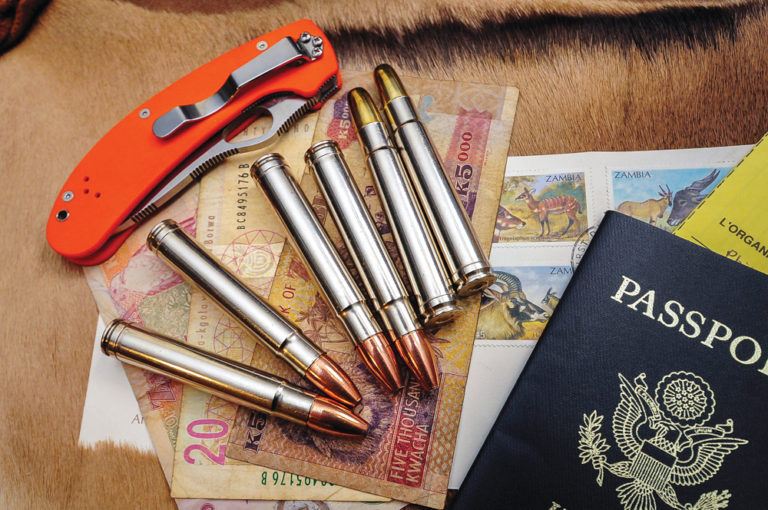
- Reloaded ammunition is just as reliable as factory ammo when facing dangerous game, assuming you have put in your time at the bench and shooting range to verify.
- Handloading dangerous game cartridges allows you to select high-performance bullets for the toughest critters.
- Many classic safari cartridges are inherently versatile, a trait handloaders can take full advantage of.
Is reloading your own dangerous game cartridges a good idea? Phil Massaro takes several .40-caliber rifle cartridges to the Dark Continent to find out.
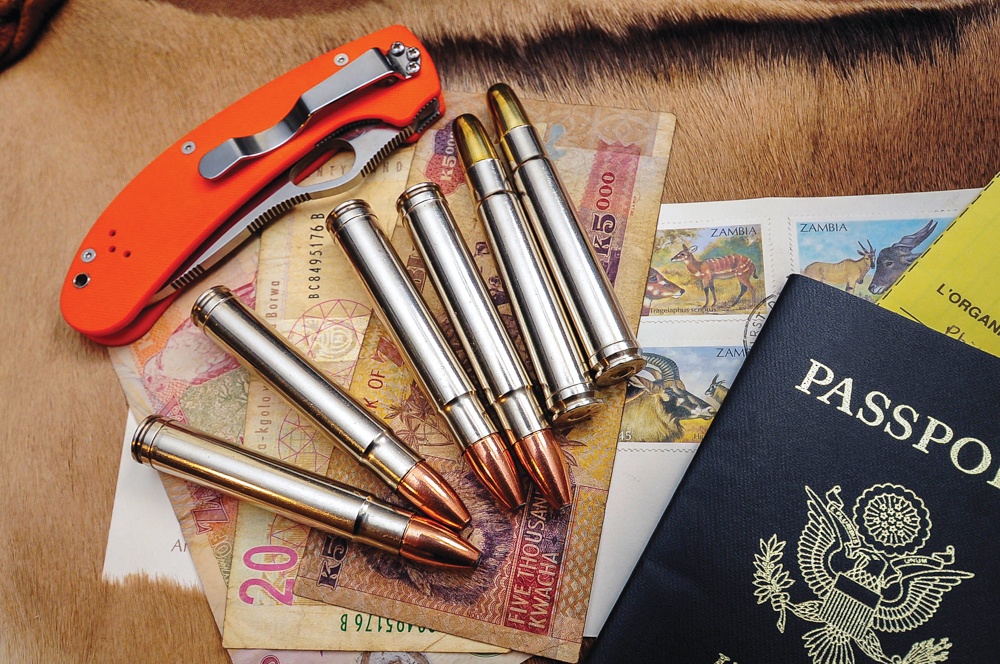
Deep into the Nyaminga block of Zambia’s Luangwa Valley, Professional Hunter Nicky Wightman gingerly spread the shooting sticks, eyeballing the Cape buffalo bull that was lying down 40 yards away. He and Lamec, his tracker and right-hand man, were silently communicating about the bull and whether or not he was old enough to take, while I stood by, with my Model 70 in .416 Remington, handloaded with 400-grain Swift A-Frames.
Although every nerve stood on edge, I knew exactly what the rifle would do, as I had spent countless hours at the bench, and in practice from field positions. While the gun gave acceptable accuracy with factory ammunition, it shot sub-MOA with my handloads, and I knew that was the proper ammunition to use.
We sorted that bull out with a well-placed first shot, and a second A-Frame to ‘pay the insurance,’ as the saying goes, and both bullets rested against the offside shoulder skin. They gave perfect performance, imparting all 5,000 ft.-lbs. within the bull, and killed quickly and humanely.
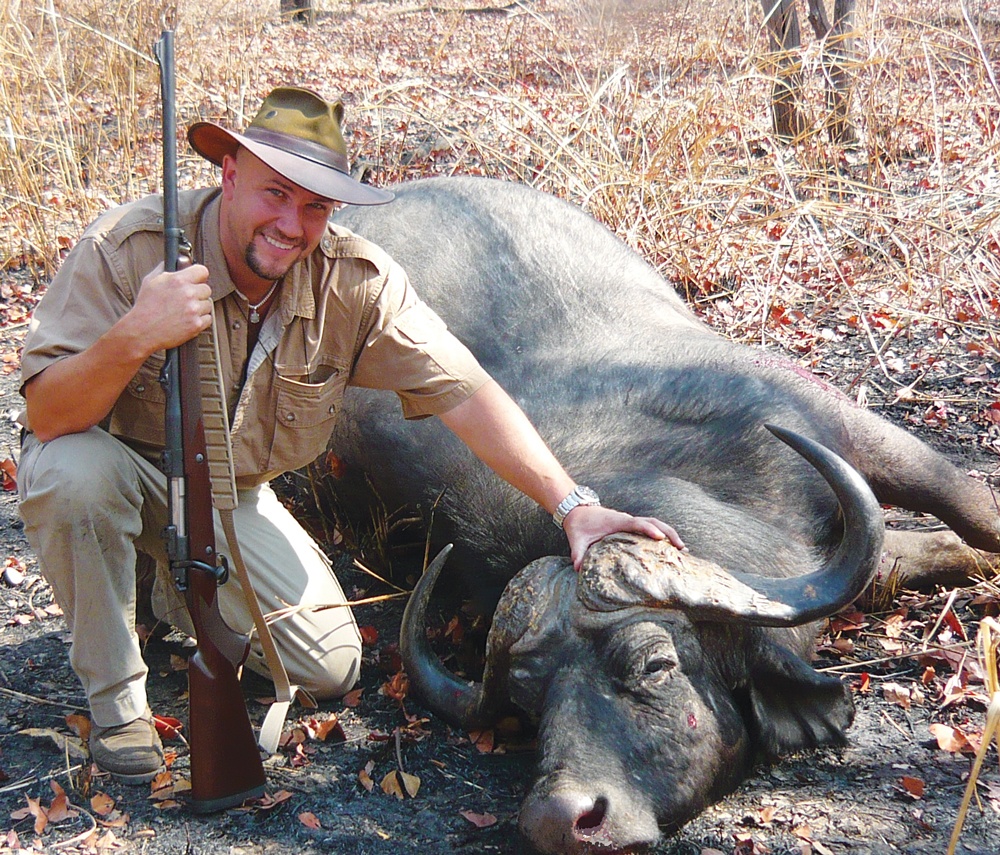
Fast forward almost four years and I stood with PHs Tim Schultz and Danie Wingard in Matabeleland North in Zimbabwe, with a huge-bodied bull elephant on the other end of the line. This time I carried a Heym Express in .404 Jeffery, handloaded with 400-grain Woodleigh Hydrostatically Stabilized Solids, at a muzzle velocity of 2,280 fps. It was a short hunt, and the bull was essentially gift-wrapped, feeding at 16 yards.
The first shot nearly put the bull down on his haunches, and the second sealed the deal. My hunting buddy Dave deMoulpied had booked this hunt for me, and had come along as a camera man. After the bull was down, and the respects were paid, Dave showed me the footage. The Woodleigh solid had hit exactly where aimed, and the video showed the effect of that well-designed bullet, a heart/lung shot which penetrated the entire elephant.
“Buddy, I’m glad you went with the Woodleigh,” said Dave. “That hit was as impressive as the shots I’ve seen from .470s.” Now, I know for certain that the .404 Jeff is not the equal of the mighty .470 Nitro Express, but it is a perfectly viable big game cartridge, suitable for absolutely anything on earth. That’s what I want to discuss: the benefits of handloading rifles in the .410-.423 calibers, and why they make so much sense for the traveling hunter.
Everybody who has hunted Africa is aware of the versatility of the famous .375 H&H Belted Rimless Magnum; there’s simply no denying the fact that a good .375 H&H will get the job done, regardless of species. I’ve heard from more than one PH, “When in doubt, bring a .375 H&H.”
That said, when it comes to the heavyweights like buffalo and elephant, there’s no denying that the .40s hit harder, and the visible effect of the shot is plainly evident. However, the beauty of the .375 is its versatility; it can take the biggest elephant bull, but is also suitable for oribi, duiker and steenbok.
I own a .375, I shoot it and I love it, but I’m also a huge fan of the .40s for reasons we’ll outline shortly. What I like to do as a handloader, is to do my best to approximate the versatility of the .375s in the .40 calibers.
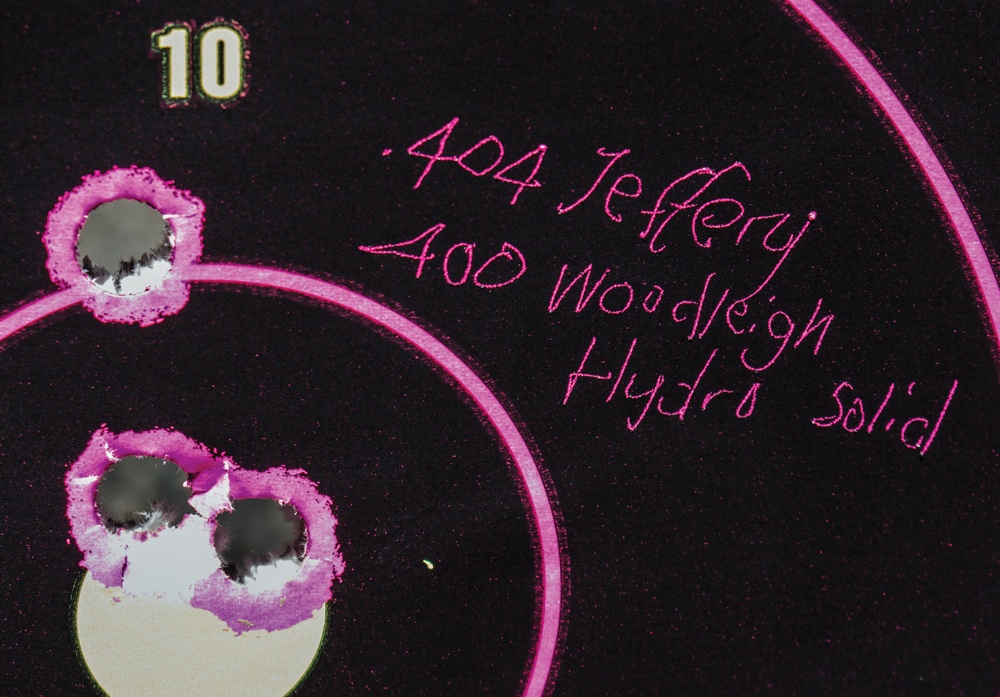
In this class of rifles, I like the following cartridges (in order of caliber) for a versatile hunting rifle: the .450/400 3” Nitro Express, the .416 Rigby, the .416 Remington, the .416 Ruger, the wildcat .416 Taylor, and the venerable .404 Jeffery. All of them have made their reputations shooting a 400-grain bullet of good sectional density, at muzzle velocities of 2,050 fps (for the .450/400), up to 2,400 fps for the .416s, with the .404 coming in somewhere in the middle, depending on how you load it.
The classic recipe of the 400-grain bullets at 2,400 fps from the .416s will yield just about 5,000 ft.-lbs. of kinetic energy at the muzzle, yet is surprisingly easy on the shoulder, especially in comparison to the .458s pushing a 500-grain slug at 2,150 fps or so.
The .450/400 3-Inch Nitro Express
The .450/400 NE works well at the much lower velocity, being a perfect choice for the recoil-sensitive shooter to use against the heavyweights. The penetrative qualities of the .410-inch diameter bullet are legendary; flipping through John ‘Pondoro’ Taylor’s classic African Rifles and Cartridges will yield the following comments:
“It’s one of the grandest weapons imaginable for all big game hunting… …I have used it extensively on all kinds of African game from elephant down with the greatest possible satisfaction.”
That is what I would call a ringing endorsement from a man with decades of field experience. The bullets of today are much better than those of Pondoro’s era, and the recent revival of this case is due to Ruger chambering their No. 1 single-shot rifle in this cartridge, and Hornady’s factory ammo available with the potent combination of DGX and DGS bullets.

My buddy Doug Giles, international hunter and author of Rise, Kill and Eat, is a huge proponent of the .450/400, and has both the No.1 and a sweet double in this cartridge. He asked me to handload some ammo for his upcoming safaris, which will include buffalo and big cats. I immediately recommended the North Fork trio of bullets: the semi-spitzer bonded core, the Percussion Point (similar to the semi-spitzer, but skived at the nose for greater expansion on cats), and the fantastic monometal Flat Point solid, all in 400-grain configuration. His double regulates well with the existing Hornady ammo, but Doug was after a custom ammunition experience.
I got my hands on some Hornady cases and a set of RCBS dies, and taking a long look at several reloading manuals, I settled on a load of 83.0 grains of Alliant’s Reloder-19 and a Federal GM215M primer, which gave a muzzle velocity of 2,075 fps, in close proximity to the Hornady load, and (thankfully!) it shot just perfectly from Doug’s rifles. He is now well equipped for any game animal on earth, including the dangerous stuff of Africa and North America.
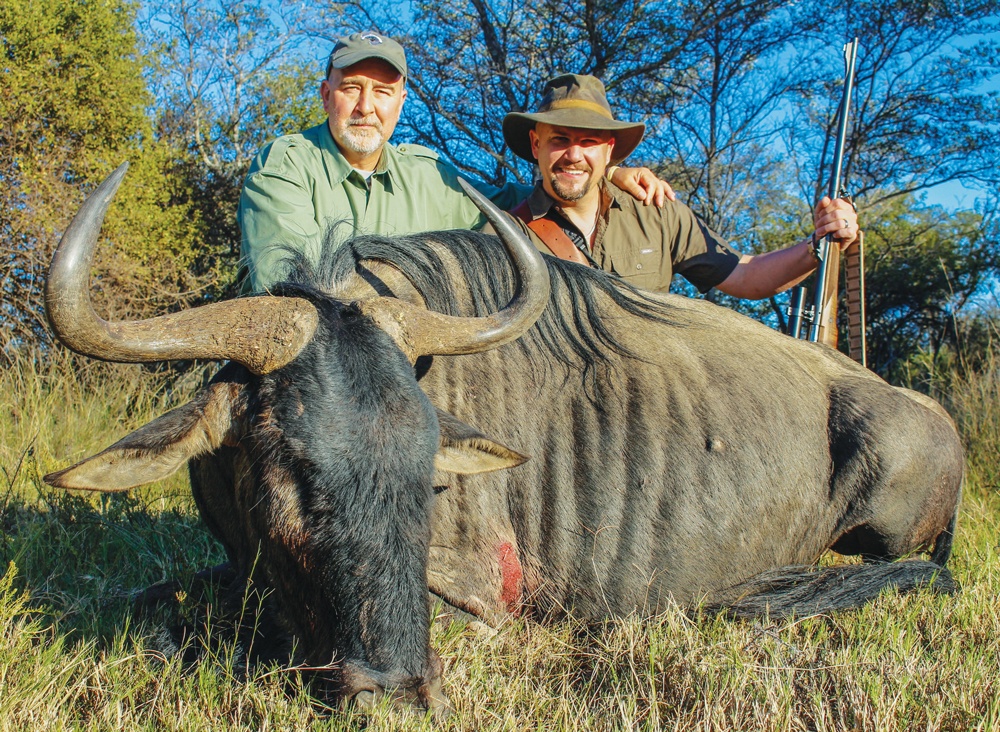
The .416s
Undoubtedly, we owe the popularity of the .416-inch diameter cartridges to the writings of Robert Ruark, as he made both PH Harry Selby and the .416 Rigby famous in his classic safari book Horn of the Hunter. I, for one, am very happy he did that, because prior to that 1950s literary gem, the .416 was a proprietary cartridge that was little used.
During the 1960s and 70s, as Kynoch faded away as an ammunition producer and supplies dwindled for the classic British rifles, an American PH named George Hoffman necked the .375 H&H case up to hold .416-inch bullets, resulting in the .416 Hoffman.
Bob Chatfield-Taylor did a similar thing, but based his case on the shorter (2.500-inch) .458 Winchester Magnum case, giving birth to the .416 Taylor. Remington saw the value of the Hoffman design, and modified their 8mm Remington Magnum case to create the .416 Remington Magnum, released in the year I graduated high school, 1988. The Hornady/Ruger team had great success with the .375 Ruger cartridge, and modified the beltless design to yield the .416 Ruger, fitting in a standard-length rifle action.
All these cartridges, generally speaking, deliver the wonderful 400-grain .416-caliber bullet at or near 2,400 fps, and this is a magic combination. For the handloader, there are many premium 400-grain bullets available that aren’t commercially loaded.
Remington did, at one time, load the 400-grain Swift A-Frame for the .416 Rem, but I don’t find that in their catalogs any longer. I’ve said this before, but it warrants repeating: I feel that the Swift A-Frame, in a heavy-for-caliber weight, is the best Cape buffalo bullet on the market. It gives good expansion at a wide range of velocities, fantastic (90%+) weight retention, but most importantly it is strong enough to penetrate the biggest buffalo at any angle. I’ve used it extensively in my .416 Remington, not just on buffalo, but on a wide variety of plains game, from bushbuck and puku, to warthog and hartebeest, all with good results.
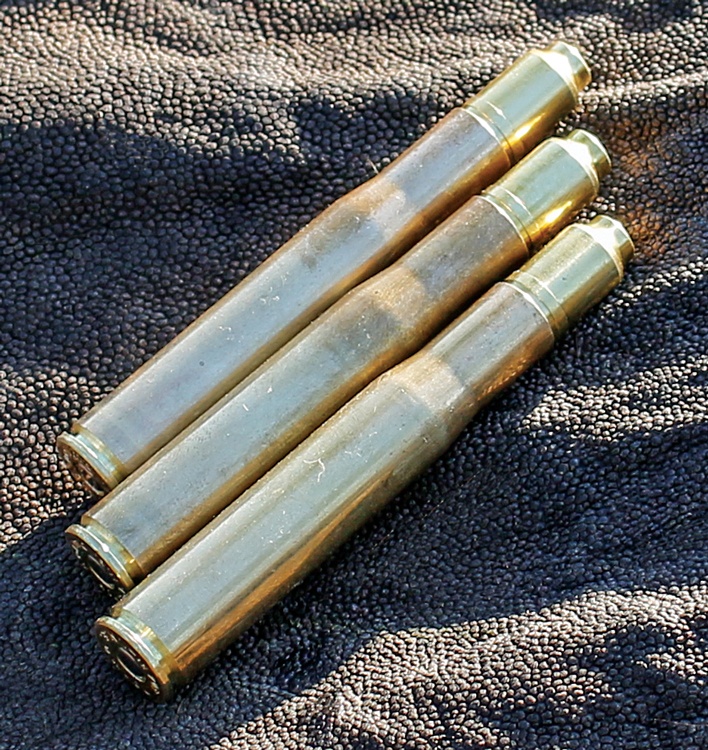
Dave deMoulpied’s AHR in .416 Rigby loves the 400-grain A-Frame, but at a reduced velocity of 2,250 fps, because that’s where we found the accuracy. Ninety grains of Reloder-19 prints three of them into sub-MOA groups at 100 yards.
Pair these A-Frames with a good solid and you’ve got the quintessential buffalo battery. While the Barnes Banded Solids, Trophy Bonded Sledgehammers and Hornady DGS are fantastic choices, for buffalo especially, I like a pair of ‘new-wave’ designs that have come along.
The idea is this (although it is changing quickly): The first shot on buffalo should most definitely be a premium soft point, many of the older Professional Hunters demand a solid (read non-expanding) bullet for the follow up shots, to ensure penetration from any angle. The solids give exactly that; but offer no expansion at all to destroy vital tissue. Here’s where the new-wave designs enter the mix.
The Woodleigh Hydrostatically Stabilized Solid, and the North Fork Cup solid, both have a small “dish” shaped meplat, enough to either create a shockwave of damage, or to give the slightest bit of expansion at the meplat for more tissue damage than traditional solids give. For buffalo, I like them both very much. Both shoot very accurately, and most importantly, to the same point of impact as most of the premium softpoints.
That idea of getting your solids to hit the same place as your softpoints, can be a bit of work for the handloader. The .375 is one of the most forgiving calibers in that respect, and I can say that my .416 Remington is as well.
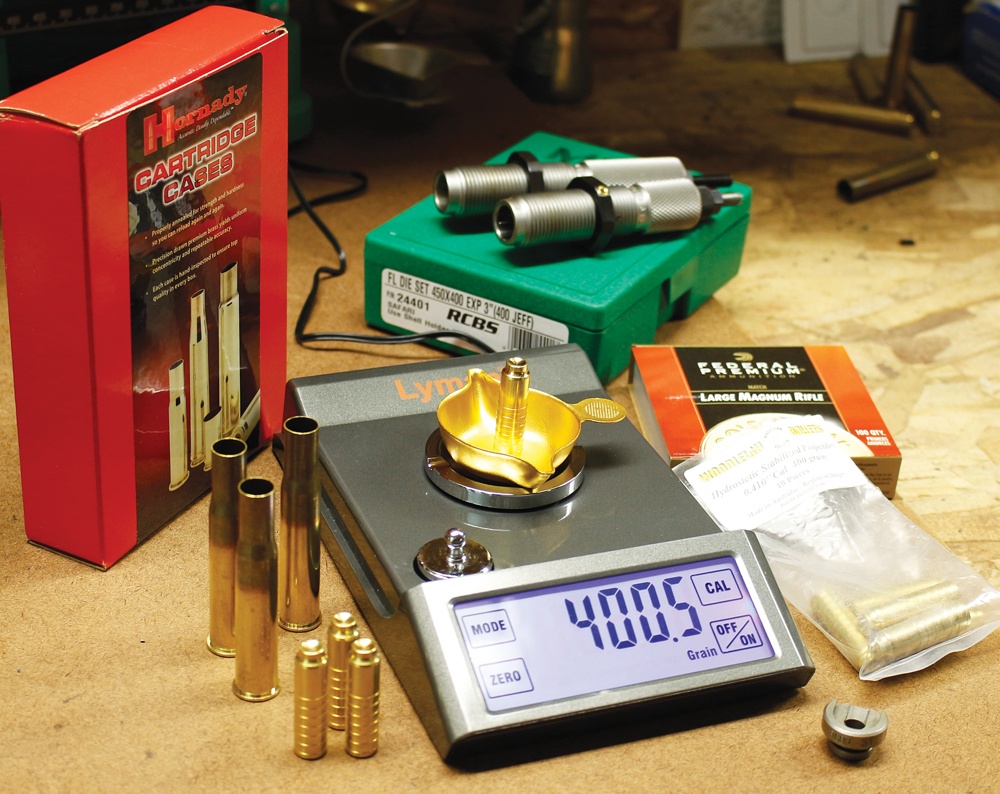
My Model 70 .416 Remington likes just about any 400-grain bullet over a charge of 78.0 grains of IMR-4064 with the Federal GM215M primer. I use Remington nickel cases for the solids, and Norma brass cases for the softpoints, so I can easily distinguish one load from the other. If your rifle won’t regulate softs and solids to the same point of impact, you’ll have to tinker with the loads until you can find the best combination of individual accuracy for each load, and a common point of impact.
Generally speaking, I’ve found that backing off the load a grain or two for the solids can help bring them into line; in my experiences they tend to hit high.
Now, more about that versatility thing I mentioned early on. The .416s certainly shine when using the 400-grain slugs, and that weight makes a great all-around load. It’s been my go-to choice for my .416 Rem. on two safaris, and it works well.
But maybe there are situations where you’d like to use a .416 with a lighter load, for a flatter trajectory. That very thing happened to me on my last safari. It was actually two safaris in one, as Dave deMoulpied and I were hunting for three days in the Waterberg District of South Africa for plains game, and then heading up to Zimbabwe for elephant near the Hwange National Park. I had the aforementioned Heym in .404 Jeffery, but I asked Dave to bring his .416 Rigby, in case some misfortune should befall the Heym.
For plains game, we discussed some lighter bullets that would give suitable performance and a flatter trajectory, should a longer shot present itself.
Enter Cutting Edge Bullets, with their 325-grain Safari Raptor. These bullets are constructed of brass, with a deep hollowpoint. The walls of the hollowpoint are skived, so that when the bullet strikes flesh, the walls of the hollowpoint break into small blades, creating all sorts of impact trauma. The rest of the bullet remains at caliber dimension, to penetrate very deep into the vital organs, often penetrating the entire animal. Really cool concept, and I was eager to put them through field tests.
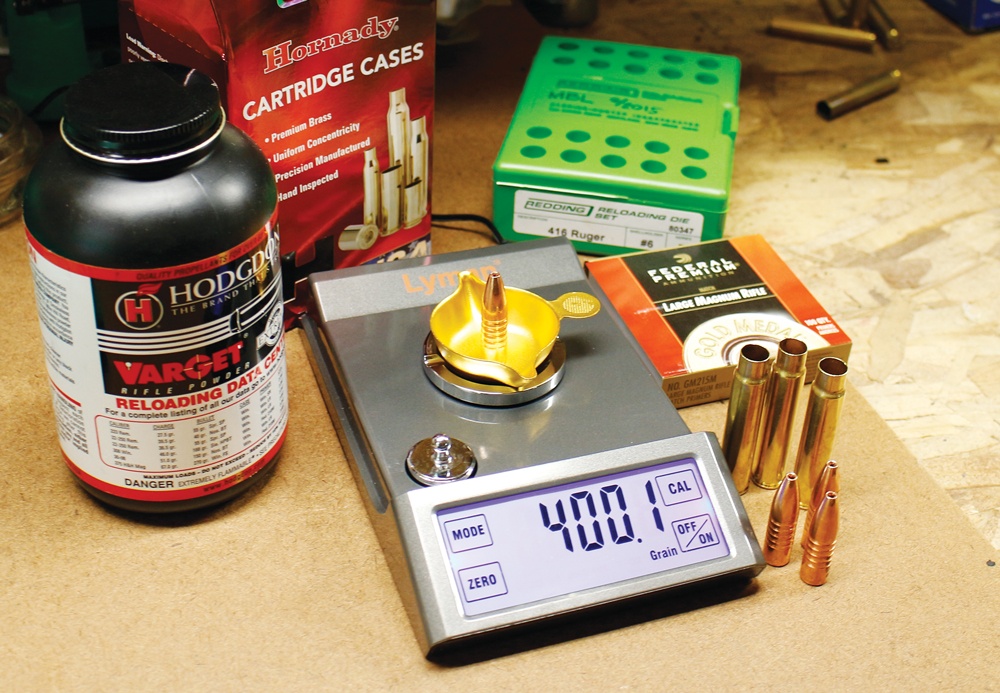
We pretty much nailed it on the first try. A mix of Hornady .416 Rigby cases, an even 100.0 grains of Reloder-22, Federal 215 primer and the CEB 325-grain Raptor printed groups of just under an inch at 100 yards. Dave made a few clicks of adjustment on his scope, and he was set. The Oehler chrony showed 2,550 fps, so longer shots wouldn’t pose a problem.
The big cow wildebeest dropped to a frontal shot from 80 yards as if she were pole-axed; and Dave’s impala didn’t even have time to react. Both were one-shot kills, and while there may have been a bit of bloodshot meat, these bullets certainly did their job. It was Dave’s zebra that impressed me most.
The striped horses of Africa have a reputation for being very tough, especially if hit improperly. Dave put that 325-grain Raptor right in the boiler room, a perfectly placed shot, from just under 200 yards away. The beautiful mare simply fell out of the scope. These lighter bullets do quite a bit for the versatility of the .416s, especially when hunting plains game. Other that the blades, there was nothing for the skinners to recover.
On the other end of the spectrum, there are some heavyweights available for the .416 rifles as well. Woodleigh’s Weldcore and Solid bullets both come in 450 grains, and we can drive them to 2,150 fps. Those heavy 450s have a sectional density of 0.371, and should be fantastic for buffalo, elephant, hippo and other plus-size game animals. Another way to look at it is that you’re only 50 grains lighter than the .458s, and while you’ll be giving up a bit in frontal diameter, you gain in the SD figures.
The .416 Ruger case is, like the Rigby, a beltless case, but shortened to fit in a standard .30-’06 length action. My good buddy Tim Wegner absolutely loves this cartridge, and asked me to handload him some of the fantastic 400-grain Barnes TSX bullets.
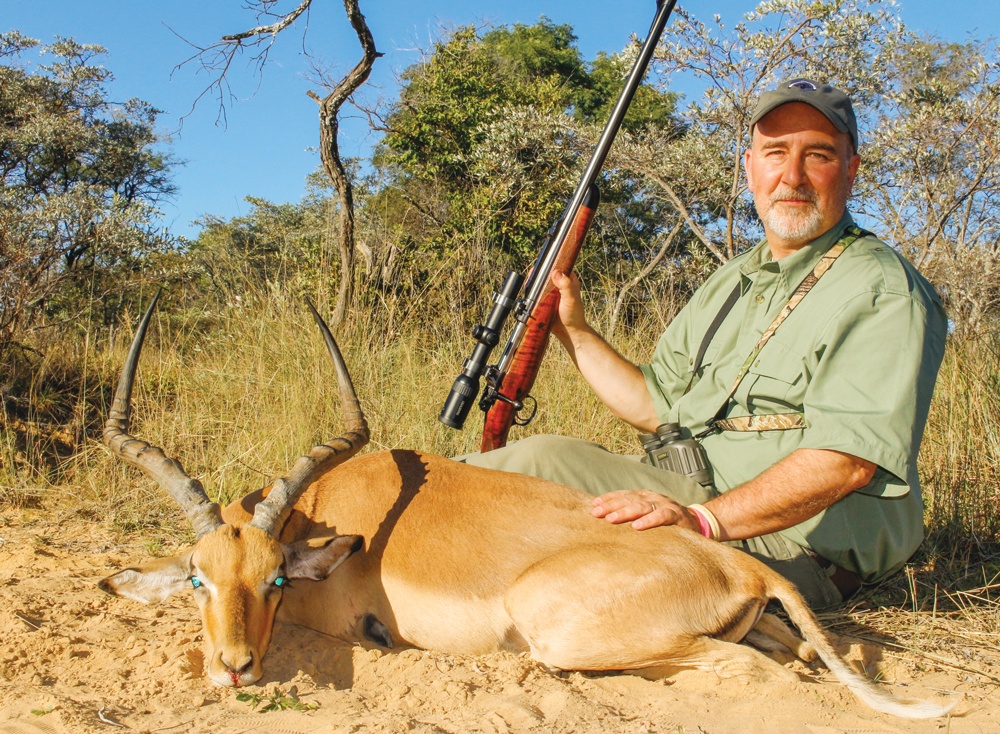
While the factory stuff claims to reach the mystical 2,400 fps, even in the shorter Ruger African barrels (I haven’t had an opportunity to test the factory stuff), according to the manuals the handloads should run somewhere between 2,250 and 2,300 fps.
I had the best blend of velocity and accuracy using 75.5 grains of Hodgdon’s VARGET, in Hornady cases, fueled by a Federal GM215M primer. This gave 2,270 fps at the muzzle, and just over MOA accuracy – plenty enough for big bears, buffalo, or any other nasty worthy of a premium softpoint.
Among the .416s, I’ve found that the Rigby case gives the most severe recoil, due to the fact that the voluminous case (designed around the temperature sensitive Cordite) requires 90-100 grains of powder, depending on burn rate, while the Remington and Ruger cases run at 75-80 grains for most loads, albeit at a higher pressure.
While I like the Rigby, and appreciate its place is African cartridge history, I feel that the Remington case especially has been one of the most useful modern updates of a proven classic, offering all the same ballistics in a cartridge case and rifle that is smaller and handier in the field. The Rigby case will work best with powders on the slower end of the spectrum, like IMR4350, Reloder-19 and 22 and H4831, while the Remington and Ruger cases like a medium burning powder, like Reloder-15, IMR4064 and Hodgdon’s VARGET.
The .404 Jeffery
I feel like I’ve found a new old toy in the attic; the .404 Jeffery was always a cartridge that interested me, but until recently I didn’t have an opportunity to experiment with it. My buddy Chris Sells, of Double Gun Imports, acts as the importer for Heym rifles of Germany. While Heym has a fantastic reputation in the double rifle community, their Express bolt-action rifle is a little-known gem.
Stocked to feel like a fine British rifle of classic vintage, and using Heym’s proprietary action, which they make differently for each individual caliber, this rifle is poetry in steel and walnut, balancing like a fine shotgun. When Chris offered the use of a .404 Jeffery for my plains game/elephant safari, I jumped at the opportunity.
The .404 Jeff has long been an African classic, being chosen as the standard issue rifle cartridge for most of Eastern and Southern Africa’s game rangers, and its moderate recoil and striking power offer a fantastic balance of shootability and performance.
Ruark’s writing propelled the .416s to the forefront, but the .404 was truly the workhorse of Africa. Designed in 1909, the Jeffery case was intended to be the rimless equivalent of the .450/400; however the bullet diameter changed from .410 to .423, for reasons I can’t explain.
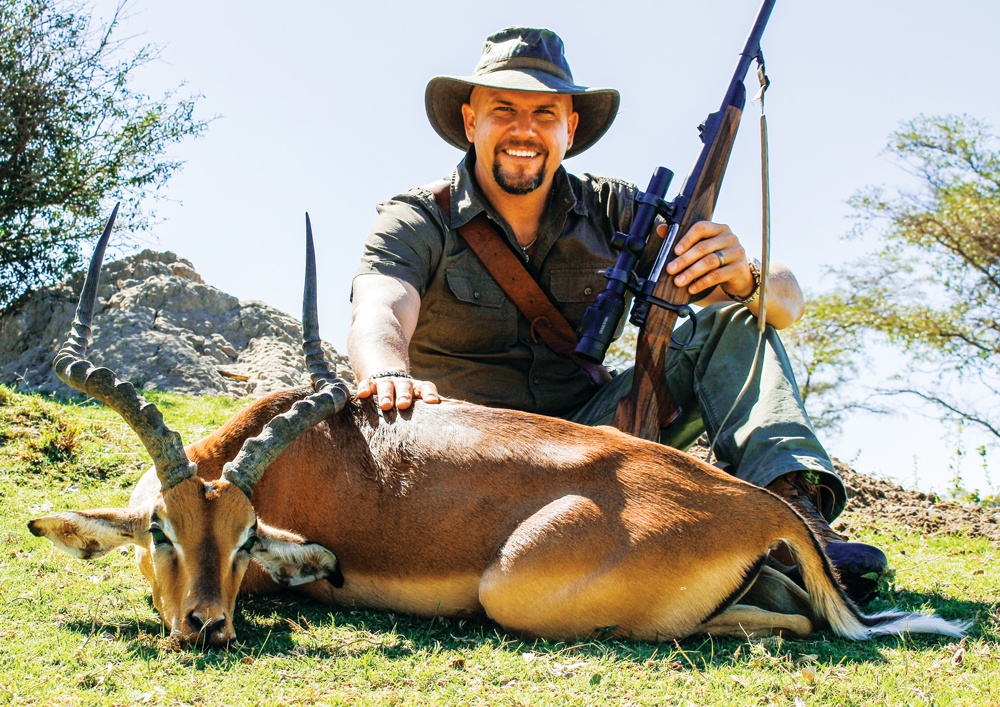
At any rate, the muzzle velocity of 2,150 fps with a 400-grain bullet generated just over 4,000 ft.-lbs. of energy, more than enough for the largest game, but the sedate muzzle velocity is directly proportional to the moderate recoil. I will say that the felt recoil of a .404, with the classic loading, is less than that of the .375 H&H, especially in recoil speed. The older load’s velocity is easy to attain as a handloader, and still works as well as it did in 1909.
The modern load is the 400-grain bullet, driven to 2,350 fps, putting it in the same league as the .416s. My own load for my safari was somewhere in the middle, and it worked out just perfect. I was using the 400-grain Woodleigh Hydrostatically Stabilized solids, over 80.0 grains of Reloder 15, sparked by the Federal GM215M primer, in Norma cases.
This combination yields 2,280 fps at the muzzle, for around 4,650 ft.-lbs. of energy, and will print MOA three-shot groups if I do my part. As I told you early on, this Woodleigh bullet gives fantastic penetration, and they worked well on both wildebeest and impala in addition to the huge-bodied bull elephant.
For a good all-around load, the Woodleigh Hydro solid is a fine choice. The other bullets I tried, like the 400-grain Hornady DGS and the North Fork semi-spitzer, liked the same load. While other powders will certainly work, I like Reloder 15 as a good medium burn rate choice.
Being a curious creature, I wanted to see if that Cutting Edge Safari Raptor that worked so well in Dave’s .416 Rigby would perform in the Jeffery. At 325 grains, it gave up a bit of the sectional density that the 400 grainers will give, but can be loaded to a higher velocity. The Heym liked them very much, putting them into MOA accuracy, and actually printing them to the same point of impact as the 400-grain Woodleighs. 85.0 grains of Reloder 15 gave a velocity of 2,560 fps, bringing the .404 into the realm of the .375 H&H, as far as decent trajectory goes.
I brought that load over with me, with the intention of taking a bush pig with it. My PH, Cornus du Plooy made a great blind and set up, and while we put our time in, the bush pigs decided not to take part in our particular hunting adventure.
Norma has introduced a new load for the .404 Jeff, in their African PH line of ammunition. PH Kevin ‘Doctari’ Robertson has helped to shape the ballistics, and it is well thought out in addition to being very useful. Their factory ammo pushes a heavy-for-caliber 450-grain Woodleigh softpoint and solid at 2,150 fps, for 2,650 ft.-lbs.
This makes good sense, especially for buffalo and elephant. The lower muzzle velocity has worked with the 400-grain bullets for over a century, but with an additional 50 grains of bullet, the sectional density figures increase considerably, which will make a cartridge that has a reputation for incredible penetration even better.
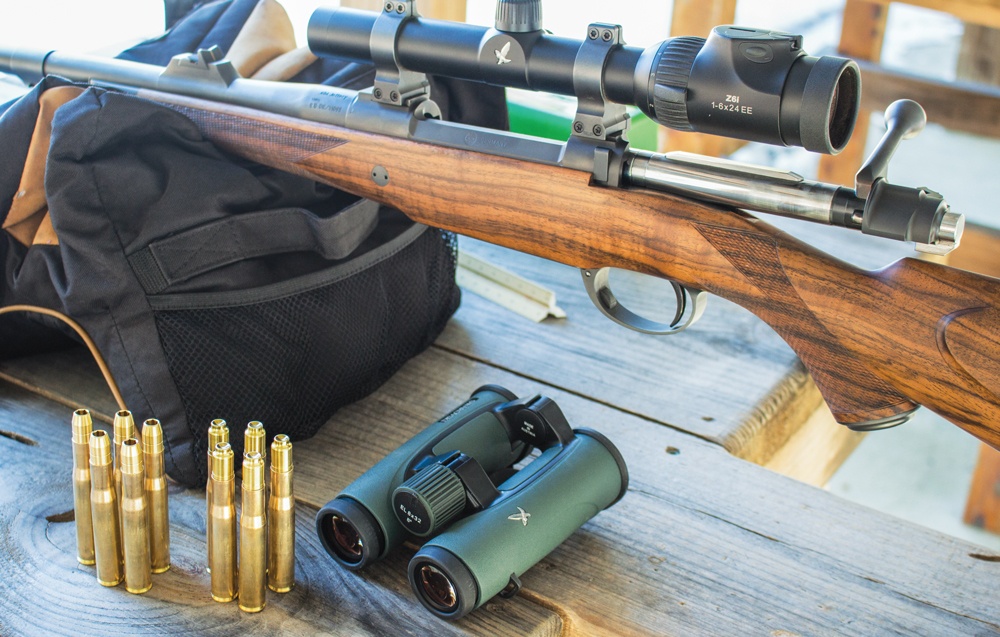
We can reproduce this formula at the bench. These Woodleigh bullets are available in component form for us handloaders, and if the heavyweights are on your list, there is no reason not to take advantage of them.
I think that the 450-grain Woodleigh Weldcore would make a terrific bullet for big grizzly bears, interior or coastal. You’ll definitely want a large rifle magnum primer, and I’d stick to powders on the faster end of the spectrum, as the longer bullets will start to eat up some of your case capacity.
With an effective bullet range of 325 grain up to 450 grains, and good cases produced by Norma and Hornady, the old Jeffery case should be seeing a revival in the next decade. Get a good set of dies from RCBS or Redding, and find a rifle that fits you well. After my safari, I called Chris Sells of Heym and asked him to hold on to the return shipping label for that Heym Express, and send an invoice in its place. I’ll be hunting with this rifle for years to come.
Conclusion
I’ve had people tell me that my sanity is questionable because I hunt dangerous game with handloaded ammunition. While I totally agree with the fact that factory ammunition is better than it’s ever been, I feel that the diligence that I put into assembling the ammunition cannot be matched by the machines.
I weigh the bullets, resize all the brand new cases, weigh every powder charge, and make sure that each and every round I intend to hunt with has been run through the rifle’s chamber, to ensure that there will be no feeding issues. After five safaris, I can honestly say that with the exception of .22 LR ammunition, I’ve never pulled the trigger on factory ammunition in the game fields, and I’m totally OK with that!
Editor’s Note: This excerpt is from Handloader’s Digest, 19th Edition available now at GunDigestStore.com
DISCLAIMER: Any and all loading data found in this article or book, including past or future editions, is to be taken as reference material only. The publishers, editors, authors, contributors, and their entities bear no responsibility for the use by others of the data included herein.

Next Step: Get your FREE Printable Target Pack
Enhance your shooting precision with our 62 MOA Targets, perfect for rifles and handguns. Crafted in collaboration with Storm Tactical for accuracy and versatility.
Subscribe to the Gun Digest email newsletter and get your downloadable target pack sent straight to your inbox. Stay updated with the latest firearms info in the industry.

![Best Concealed Carry Guns In 2025 [Field Tested] Wilson Combat EDC X9S 1](https://gundigest.com/wp-content/uploads/Wilson-Combat-EDC-X9S-1-324x160.jpg)


![Best 9mm Carbine: Affordable PCCs [Tested] Ruger Carbine Shooting](https://gundigest.com/wp-content/uploads/Ruger-Carbine-Shooting-100x70.jpg)
![Best AR-15: Top Options Available Today [Field Tested] Harrington and Richardson PSA XM177E2 feature](https://gundigest.com/wp-content/uploads/Harrington-and-Richardson-PSA-XM177E2-feature-100x70.jpg)
